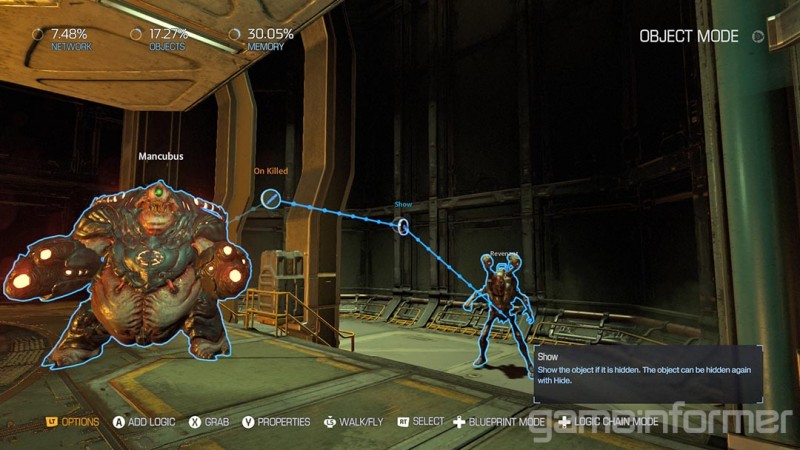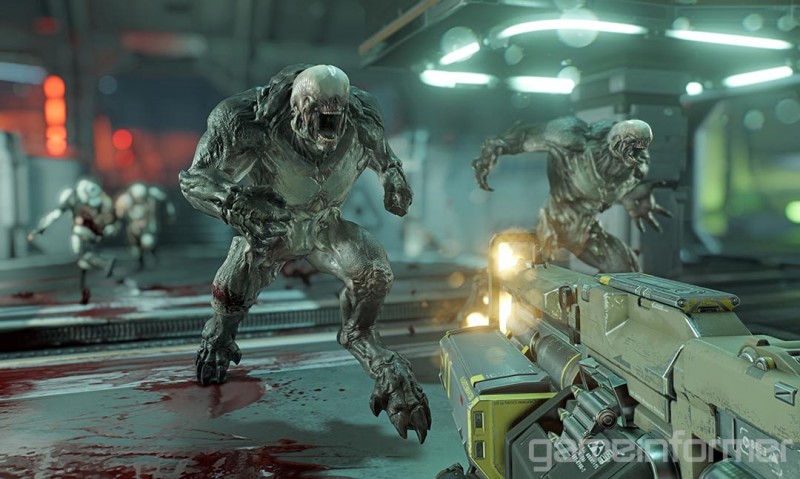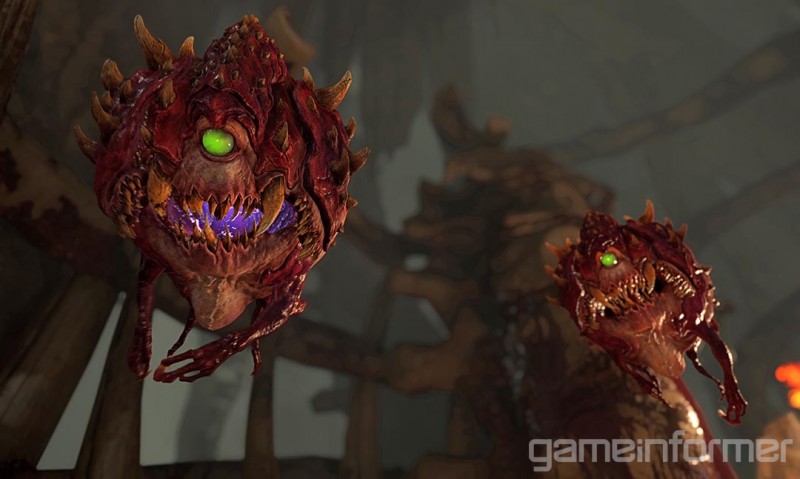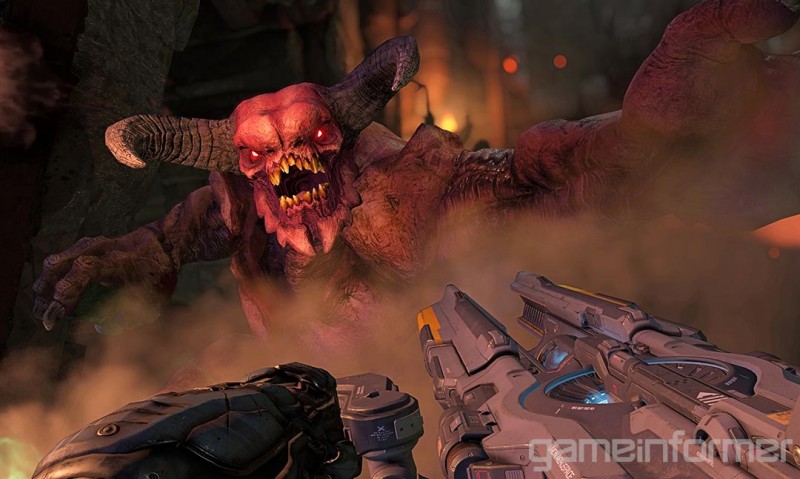Subscribe today to receive the next issue of Game Informer, featuring the Most Anticipated Games of 2026!
Doom: 10 Badass Moments From Our Hands-On Session
When you play Doom, you have to discard a decade’s worth of first-person shooter conditioning. If your weapon is low on ammo, don’t even think about tapping a button to reload it, you can’t – the only way to replenish ammo is by picking it up. The tendency to duck behind cover to regain health or survey the battlefield also holds no weight in Doom. The second you stop moving or turn your back on the demon onslaught is the second you likely die. You need to keep moving, and you only do it at one pace: sprinting. Doom also does away with changeable movement speeds, and instead sets sprinting as the default.
By removing these life-saving mechanics from the experience, Doom is unlike any other modern-day shooter on the market. We traveled to id Software’s development studio in Richardson, Texas, to put these unique, retro mechanics to the test in our exclusive hands-on session of Doom. We played through two distinct areas: The first is Resource Operations, serving as the game’s second level set in a UAC bunker deep beneath Mars’ surface. We also traveled to Titan’s Realm, a stage set in the back half of the adventure that shows off id’s new interpretation of Hell, a place where giant titans once resided. We know these titans were alive at one point because we see their remains firsthand. Holding true to Doom's heritage for high levels of gore, we actually explore the remains of one of the titans, entering through its mouth and dropping into its bowels, where most of the stage is set.
The videos of Doom that are online make the game look fast, but you really don’t realize just how fast it is until you get your hands on the controller. I played the PC version, running at a smooth 60 frames per second in 1080p, and learned quickly that Doom requires a different mindset for combat. While the ultimate goal is to blow away every demon as quickly as possible, you are pushed to concoct strategies on the fly, thinking not just of the next kill, but of your next series of moves, all while trying to keep the opposing forces in front of you, or in a position where their attacks can’t reach you. Verticality plays a large role in the game; enemies such as imps, who are far more skilled combatants than in previous games, use vertical spaces against you, scaling pipes to rain fireballs and charged fire blasts down on you.
Once I grasped the flow of combat (which felt fantastic in our demos), Doom proved to be a wickedly good time that empowers player skill and pushes players to develop their own style of play through its weapon variety. The thrills that come from Doom are as distinct as the gameplay mechanics, ranging from skill-driven chain reactions that can turn a handful of enemies into a smoldering bloody mess to satisfying finishers that give the player a few seconds to pause and admire their handiwork before the fray continues at a relentless pace.
Here are 10 of the coolest things we did while playing Doom’s campaign levels, multiplayer modes, and SnapMap – the game’s built-in modding tools:
Unlocking the combat shotgun’s explosive shot
Doom’s new take on the Shotgun is loud, and every bit as powerful as it has been in the past. In its default setting, the Combat Shotgun can be used to down any foe, but it receives an extra kick from a mod. Deep within the Resource Operations mission, players stumble upon a delivery drone that offers one of two mods for the Combat Shotgun: a three-round charged burst (executed by holding the Left Trigger to charge) and the Explosive Shot, which acts just like a grenade launcher. Both mods can be equipped at once and are switched by pressing up on the d-pad.
The Explosive Shot effectively functions as a grenade launcher, spitting out an explosive round that deals heavy damage. This powerful shot makes an already potent weapon an even greater demon killer.
Glory killing a Mancubus
The Mancubus, while looking like a waddling wad of blubber, is one of the most dangerous foes we faced during our Doom play session. Wielding dual flamethrowers and having a knack for appearing just when you least want them to, Mancubus’ must be dealt with quickly. They’ll give chase (slowly) but always seem to throw a deadly kink in the combat flow. Mancubus are bullet sponges best handled with heavy weaponry like the rocket launcher, or my preferred method, the chaingun and its three-barrel mobile turret mod.
The chaingun’s barrage of bullets tears through the Mancubus’ flesh, but if you want to glory kill it, this weapon of choice may down the foe before you get the chance to finish it off in style. When a Mancubus is stunned, the glory kill that can be executed is as gruesome as can be: Your character jams his hand into the Mancubus’ chest, removes its still-beating heart, admires it for a brief second, and then reinserts it into the Mancubus by jamming it down its throat. The Mancubus chokes on the heart for a second before exploding into a bloody mist accompanied by gooey body parts and flesh.
The first chainsaw kill
Doom’s chainsaw and BFG (which we sadly didn’t see in action) are oddly not in the weapon wheel. Id realized players would need to switch to them quickly, so the chainsaw is drawn when the player hits down on the directional pad, and the BFG is immediately wielded by press the X button (on an Xbox One controller).
The chainsaw is not immediately available for play and is found in the game’s second level, jammed halfway into the corpse of a fallen UAC trooper. Your character extracts it from the body and is given the chance to immediately reap its rewards by using it against a horde of Possessed – zombified UAC personnel.
The chainsaw is the one weapon that strikes fear into the demon forces, and always delivers a one-hit kill. Some Possessed we encountered tried to block the chainsaw’s spinning blade by raising their hands up over their heads. Their efforts proved fruitless and just lead to more gruesome deaths, as the chainsaw cuts through their arms head and torso like a hot knife through butter. The blood and guts accompanying these gruesome acts are exaggerated, but again, quickly realized, allowing the player to grind through a horde of enemies in little time.
Hot swapping weapons
The only time Doom slows down for a second is when the player dives into the weapon wheel, which slows time to a crawl much like V.A.T.S. does in Fallout 4. This brief moment of respite gives a glimpse at the immediate threats ahead, but can break the combat rhythm you may have been rocking. To avoid breaking the flow, the player can hot swap between weapons by tapping right bumper and the wheel location of the desired weapon. The weapon is switched in the blink of an eye and keeps the carnage going.
Creating a chain reaction
As calculated as you want your attacks to be, sometimes unpredictable things happen. You’ll find these moments often occur when targeting the Possessed Engineer enemy type. This former UAC welder wears an explosive container that starts on fire when shot, and eventually explodes. If the canister is on fire and the trooper is knocked back into a pile of red explosive barrels, mayhem is unleashed. We used this technique to down a swarm of enemies, but also sustained a fair bit of damage in the process. Again, you have to keep each enemy type in mind when orchestrating your attack plans.
Developing your own play style
Game Informer’s crew of Matt Bertz, Wade Wojcik, and I all played Doom in different ways. We also saw Hugo Martin, id Software’s art and creative director, play through the game using an upgrade path that favored speed. The upgrades he chose allowed his character to mantle faster, switch weapons faster, swap mods faster, and glory kill faster. He also used a speed boost that stacks. He showed us how this configuration played out in a new stage called Lazarus Facility. This UAC research lab is surprisingly bright for a Doom game, almost looking like a Cerberus lab from Mass Effect 2, with white walls, state-of-the-art technology, and vibrant florescent lighting raining down on it all.
Id wasn’t willing to show off the upgrade systems or even talk about them at length during our time in the studio, but from what we saw in this playthrough, it looks like players will have a heavy hand in sculpting the character they want from a functionality standpoint.
Locating the hidden plasma rifle
Doom isn’t all about combat. When the demon legion isn’t trying to sever your head from torso, exploration takes center stage. The UAC environments are densely populated with high technology and containers in various states of disarray.
Each new area or bulkhead brings up exploration options. You’ll stumble upon locked doors requiring key cards (just like the old Dooms), and if you are thorough in your investigation, you'll find hidden areas tucked off to the side or occupying vertical spaces. I found a series of crates I could ascend, leading to a full armor pickup. Another series of vertical maneuvers gives way to the plasma rifle, which can also be obtained later in the game, but can be added now for eagle-eyed players. Marty Stratton, Doom’s game director and executive producer, says secrets like this are in great abundance and should give players plenty of reason to veer off the critical path to explore.
Grabbing a demon token in multiplayer
Controlling hero characters in multiplayer is usually an exhilarating experience, and Doom doesn’t disappoint in this regard with the demon token, an item that appears in the environment and turns the player into a monster that can rampage until it's downed by the opposing force. In the multiplayer matches I played, I grabbed the demon token twice, and used it to turn into a Revenant (a giant skeleton-like beast capable of raining death from shoulder-mounted rocket launchers), and the Baron of Hell, another towering icon of Doom’s past that can quickly rack up kills. The Baron has two attacks: a melee swipe that can damage or grab enemies, and an AOE ground pound that delivers radial damage. Both of these demons aren't just nuisances for the opposition, but potential game-changers that can even the odds of a match.
Achieving the last kill in a Clan Arena match
Doom’s version of the popular Last Man Standing multiplayer mode is called Clan Arena. The first team to achieve five wins in this rapid-fire mode wins. Die once and you are out, and are relegated to the role of switching camera feeds to watch your squad mates. This mode gives players full health, armor, and ammo, but there are no pick-ups or demon tokens to grab. While players can be downed quickly with charged snipe attacks (which are difficult to achieve given the game’s speed), this mode more so embraces duels, circle strafing, and picking away at your enemy's health. In almost every one of our rounds and matches, the final duel with the last man standing on a team was intense and fun to watch. Nabbing that last kill to give your team a victory feels damn good.
Building a SnapMap level in under 30 minutes
After completing our single-player and multiplayer sessions, we were whisked away to a conference room to get our hands on Doom’s SnapMap, the mod tools id is co-developing with Escalation Studios. Both Stratton and Escalation’s president and co-founder Tom Mustaine tell us that they didn’t want to do mods in a traditional way this time. Stratton even says that he drew inspiration from Garage Band. Next, we’re thrown into a series of tutorials that walk us through SnapMap’s controls and systems. The tools are easy to use, and as clichéd as this may sound, creating a playable area is as easy as snapping Legos together.
The modular pieces can be assembled quickly, and SnapMap has a clear visual language for letting you know when objects are intersecting or are not connecting. Various camera angles and zooms make this process a breeze. Placing objects and A.I. in the environments is just as easy. The tutorial even has a fun little moment where the player is asked to place explosive barrels around enemies. You know what happens next.
SnapMap offers simple systems for almost everything – from changing how much health an enemy has to making a terminal open a door or spawn a legion of beasts. If you’re making a four-player multiplayer map, you can even assign the A.I. in the environment to the four different teams.
We flew through the tutorials, and in under an hour were playing through our own single-player map filled with hallways, weapons, health drops, and enemies around every bend.
SnapMap doesn’t offer the high level of customization that previous Dooms did, but it does open the door for everyone to be able to make maps and levels. Id says SnapMap publishing and playing is as fast as loading a level. The only download that takes place is an instruction file, as players already have all of the content they'll be accessing.
Return to our hub throughout the month for more information on the single-player campaign, arena multiplayer, and the SnapMap creation engine. You can access the hub by clicking on the banner below.

Get the Game Informer Print Edition!
Explore your favorite games in premium print format, delivered to your door.
- 10 issues per year
- Only $4.80 per issue
- Full digital magazine archive access
- Since 1991













